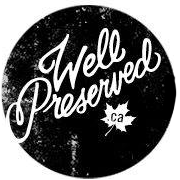
You probably thought you were so smart. You looked everything up, or bought a book. You sterilized your jars, you made sure to boil your brine, and you washed all your produce thoroughly. You used your canning rack & processed them, and proudly went to open a jar a few months (or days) later and…
Limp pickles. Gross, limp, soft pickles.
I feel your pain, and I’m here to help.
First things first. Here are a few things that can cause mushy pickles:
-
Try using an additive like Ball Pickle Crisp®. Lots of people use alum or grape leaves as well. It’s worth trying as a last ditch effort if nothing else you do works.
- Cut the blossom end off of cucumbers before pickling them. There’s an enzyme in that end that makes everything wonky & turns your cukes into mush.
-
Make sure your veggies are fresh. I know especially this is important with cucumbers. If you use out-of-season or old produce, you’ll get not-so-great results.
- Don’t wait too long to eat ’em. If you’re waiting over a year to open that jar of shelf-stable pickles, or letting fridge pickles sit for months, you’re not doing them any justice.
Another question I get is, “Do I need to use pickling salt/5% acidity vinegar when I make pickles?” The short answer: no. The longer answer is a bit more complex. When you’re making shelf-stable pickles, you do in fact need to use a vinegar that has 5% acidity. But for refrigerator pickles or pickles you plan on eating ASAP, then no, any vinegar will do. As far as pickling salt, it’s definitely not a must. You can use any salt you have on hand- but just know salt with iodide can change the color of your pickling brine & make it cloudier/discolored, which can make your pickles unappetizing.

Continuing on the canning/preserving path: “Do I really need to add that much sugar to my preserves?” This one is a tricky one. I’m kind of torn on the answer, because my initial reaction is to respond, “No, you don’t have to add ANY… but you do need some if you want them to look pretty!” However in actuality you do not. You can make preserves or jams with no sugar, provided you use the proper pectin- Pomona’s. That said, they will not last as long on the shelf and they will not retain their color as well. I have made sugar-free & low-sugar jams and the difference when stored next to a full sugar jam can be startling, especially after a few months. Peaches canned in a very low-sugar syrup can look downright gross, truth be told. But that doesn’t effect the flavor or quality any… that’s just me being a pain in the ass aesthetically. And in some jams you don’t even need to use any pectin at all: blueberries are famously high in pectin, and a little cooking with some honey, sugar substitute or even a little water brings out the jammy quality you’re looking for. Is it safe for canning to skimp on sugar? Well… yes. It’s definitely safe as long as you’re following the proper steps and using the right amount of acid. But like I said, the shelf-life will be considerably less. For a more in-depth explanation of the role of sugar in preserving, see this post from Food in Jars, and if you’re just looking to lower the sugar amounts because the internet or a fitness freak has scared you, then please read this series of posts from Local Kitchen.

Next up, “Nutritional yeast: what’s the deal with it?” Now, being I am not vegetarian or vegan I wasn’t 100% sure about this one. Of course I knew what it was- my mom uses it- but I myself had no experience with it. So I did a little research. According to everyone’s favorite site, Wikipedia:
Nutritional yeast is a deactivated yeast, often a strain of Saccharomyces cerevisiae, which is sold commercially as a food product. It is sold in the form of flakes or as a yellow powder and can be found in the bulk aisle of most natural food stores. It is popular with vegans and vegetarians and may be used as an ingredient in recipes or as a condiment.[1]
It is a source of protein and vitamins, especially the B-complex vitamins, and is a complete protein. It is also naturally low in fat and sodium and is free ofsugar, dairy, and gluten. Sometimes nutritional yeast is fortified with vitamin B12.
Nutritional yeast has a strong flavor that is described as nutty, cheesy, or creamy, which makes it popular as an ingredient in cheese substitutes. It is often used by vegans in place of cheese.[2] It can be used in many recipes in place of cheese, such as in mashed and fried potatoes, and atop scrambled tofu. Another popular use is as a topping for popcorn.[3]
In Australia, it is sometimes sold as “savoury yeast flakes.” In New Zealand, it has long been known as Brufax. In the United States it is sometimes referred to as “nooch” (also spelled nüch), or “yeshi,” an Ethiopian name meaning “for a thousand”. Though “nutritional yeast” usually refers to commercial products, inadequately fed prisoners of war have used “home-grown” yeast to prevent vitamin deficiency.[4] Nutritional yeast is different from yeast extract, which has a very strong flavour and comes in the form of a dark brown paste.
In short, if its fortified nutritional yeast, it’s a way to add B12 to a vegan (or vegetarian/plant-based) diet. Also if you’re a vegan & don’t eat cheese, it mimics the taste of cheese. So it can be sprinkled on pastas or popcorn instead of parmesan or romano cheeses. It can also be used in macaroni & cheese dishes instead of cheese. IT IS NOT THE SAME THING AS YEAST USED TO MAKE BREAD RISE. Please do not try and swap out one for the other! For more thorough information (& recipes!), please visit this page at the FatFree Vegan Kitchen. Theres way more info there than I could ever give!

Yet another question: “Why do my cupcakes deflate/collapse/sink down in the center?” This is a question I get more than ANYTHING ELSE, except for maybe “How do you stay so thin making all this good food?” which always elicits a major eye roll. It’s also a bit complex with a ton of variables, so stick with me here.
- The first thing I always ask is if your oven temperature is correct. Buying a thermometer to find out if your oven runs hot or not is always a good idea; my mom’s stove runs either right on point or a bit hot, my brand new oven bought in December runs a bit on the cool side. It happens! And it’s definitely not a new vs. old thing, or a brand issue. It can also be that your oven is electric and doesn’t get as hot as a gas oven (which is what most recipes are written on/for to be honest). Either way, that’s the first thing I’d check.
- Second, I ask if you’re using brand new baking powder/baking soda. Many people don’t realize it loses it’s potency sitting in your cabinet. So if you don’t bake often, you might want to buy smaller containers of it and not go so long in between using it. I never have this problem because it seems I’m always using my baking soda for cleaning & baking, and I go through baking powder like crazy. However according to this site: “Test baking powder by mixing 1 teaspoon of baking powder with 1/3 cup hot water. If the baking powder is fresh, the mixture should produce lots of bubbles. Be sure to use warm or hot water; cold water will not work for this test. Check baking soda by dripping a few drops of vinegar or lemon juice onto a small amount (1/4 teaspoon) of baking soda. The baking soda should bubble vigorously. If you don’t see a lot of bubbles, it’s time to replace your baking soda.”
- Third, I ask if your eggs & butter are cold. Unless the recipe states you should use cold butter, DO NOT use cold butter. Make sure its room temperature. And same goes for eggs. Yes, this can definitely influence your baked goods.
- Are you opening your oven during baking? This is a no-no. At least during the first fifteen minutes of baking, which is a vital time for the rise of the cake. I try not to do it at all with cakes/cupcakes… which is easy, since I have an oven with a glass door & light. But not all of us have that, so we have to just put our faith in the cake gods and NOT OPEN THE DOOR UNTIL THE TIMER GOES OFF.
- Did you incorporate the ingredients in the right order? Which then leads to…
- Did you follow the recipe correctly? Sometimes we misread things and don’t realize it until later. Always read the recipe twice, then have all your ingredients out and ready to go when you’re ready to make it.
- Lastly… was it a very humid day? This can sometimes affect (or effect) the quality of baked goods. Same as altitude; be sure to check your altitude before making a recipe! Once you find out, King Arthur Flour has a good chart for changing a recipe.
Another question I get a lot (I even made some frosting tutorials because of it) is: “Why does my frosting always wilt?”

This is a big problem with a lot of folks. Especially those who live in humid or very warm areas. Sometimes it’s really simple- you didn’t add enough powdered sugar, added too much milk, or skimped on the butter. Or… the butter was too soft. That’s easy to fix. Just remember; every recipe for confectioner’s sugar buttercream is a guideline. You will probably need to play around with the amount of sugar/liquid to get your frosting the desired consistency.
Other times it’s just the fact that butter can’t hold up to high humidity or high temps. I suggest using Crisco in those cases. No, it doesn’t taste as good, but if you’re really concerned with your piped up swirls lasting long enough for photos (or just lasting through the party), then it’s something to consider. Shortening holds up far better in those circumstances.
The third issue is with a Swiss meringue or Italian meringue buttercream. They do weep a bit, that’s just how it is. And if it’s a very humid day, your egg yolks will not froth and fluff properly. And it absolutely should be stored in the refrigerator! Which means that no, making it on a super hot day isn’t the best idea because it does indeed contain both butter & eggs.
My suggestion? Using Crisco in a confectioner’s sugar buttercream or using a 7-minute frosting. It holds up way better, tastes like a cross between meringue & marshmallow Fluff, and isn’t hard to make if you have a stand mixer.

This is a question that even I myself have asked. “If the very name is stainless… then why the f*%k are there stains on it!?” I have a set of stainless steel Calphalon pots and pans that I adore. We got them as an engagement/housewarming gift and I think they’re the best pots ever. That said- they started to stain the minute we began to cook with them. The “rainbowing” effect, little white spots, and some dark spots. Jay was utterly stymied at this and I admit I was too.
But while it is true that stainless is indeed MOSTLY stain resistant & a very tough material, it’s not immune to everything, especially the calcium or minerals in water and foods. The rainbowing happens most often to me when making rice (particularly rice; more so flavored/seasoned rice for some reason), and what I do is I first rinse it out and get all the rice pieces out, then clean it in the dishwasher to make sure it’s thoroughly clean. Then, if there are any spots or stains, I boil a bit of white vinegar in it. Once its boiled, pour the hot vinegar down the drain and wipe the inside of the pot/pan down with a little water & Bar Keepers Friend (or Bon Ami). Both cleaners will not scratch but are tough on all kinds of stains – even ones on vintage Pyrex, FYI! The insides of my pots come out absolutely beautiful after that.
If you don’t have those two items, baking soda can be very effective, as well as lemon juice & cream of tartar. Make a paste with some water and scrub it on. I prefer to use a Scrub Daddy, which also does not scratch. A damp dishtowel will also do the trick. Rinse it off and thoroughly dry it. These methods will also help get rid of those tiny little rust spots and stains as well.
If these steps don’t help, and you still have stubborn stains, you might want to just live with it. Do you need shiny Food Network TV show quality pans to make a good meal? No. As long as they’re clean & have a bottom and sides, they’ll work. It’s important to remember though that this is totally normal & happens to most stainless steel! Unless there are pits or dings, it will not at all affect the cooking or the use of your pots. So don’t flip out about it!
Also: don’t wash stainless steel and/or aluminum or sterling silver in the same cycle in the dishwasher. You’re actually better off forgetting you have a dishwasher & washing the two latter by hand… which brings me to…

This is very common too. In our dishwasher-obsessed culture, we forget that there are some things that are just better off with a wash in the sink using a little Dawn. We just toss every single thing in there, put it on sanitize & completely forget that you just can’t always do that!
Long story short? That powdery stuff is kind of like the “filling” of the aluminum coming out due to too-high temperatures. In other words: your dishwasher. Yeah, I know. Its actually specifically because of two things… the phosphate-free dishwashing liquids AND the high temps. Why?
In the chemical reaction between soap and aluminum ATOMIC hydrogen is formed. Atomic hydrogen has a very weird property of actually being able to move completely through solid aluminum……because it is such a small particle. Atomic hydrogen cannot be contained in an aluminum vessel…..it moves right through it as though it weren’t there. It remains in the atomic state only until it meets another atomic hydrogen atom which then produces the hydrogen molecule H2. Molecular H2, which is a gas, cannot pass through solid aluminum. This process of hydrogen going from the atomic form to the molecular form causes the metal to actually flake (sometimes even crack) helping produce the powdery residue that you saw. The hot water in the dishwasher greatly accelerated this reaction.
But don’t worry… it’s not too late! You can fix it, and while it still won’t be as pretty, the powder will go away & your aluminum will be usable again.
Here’s a few methods:
- vinegar & cream of tartar made into a paste and scrubbed on, then rinsed off (repeat as necessary)
- S.O.S. pads & water
- Cameo aluminum cleaner
I personally have had this happen to me as well, and all I can say is it taught me one thing: NO ALUMINUM IN THE DISHWASHER. I don’t really have much aluminum anyway as I prefer stainless & cast iron, but I do have Jay’s grandma Dotty’s vintage Wear-Ever aluminum pots and pans, and it’s good to know how I can clean them safely.

“How do I get my cakes to be moist?” Ah, a tricky one. A tricky, multi-layered one. The main problem behind cakes is that people beat ’em up too much. Seriously. Like the dishwasher problem above, we live in a time when everyone has a mixer- either a hand mixer or a shiny stand mixer. And we can’t wait to use them. So we whip them out (pardon the pun) at every chance we get, sometimes at the expense of our baked goods rather than anything else.
Why?
Well, because when you over-beat a batter, the flour releases more gluten. More gluten makes for a tougher, chewier product. Not to mention the fact that the more you beat it, the more air gets in, which also makes it drier. Which would be great for breads (hence the endless kneading involved with most bread) but not so great for cakes. And so, no matter how much oil or butter is in there, the cake will end up tough and on the dry side. This can be solved by ONLY using a mixer to cream butter and sugar, and using a good old fashioned wooden spoon to mix the rest of it. Save your mixer for cheesecakes, breads, meringues & other stuff & keep cakes simple. And you know how it says “until just combined”? Yeah. Exactly.
If that doesn’t work, switch to cake flour, and continue to use the wooden spoon technique. I promise you your cakes will be much fluffier and moister..er. Er.
Another cake problem? Eggs or butter not at room temperature. Yes, this makes a huge difference. Sugar sort of aerates, or pokes holes into the butter in a proper situation. If the butter is cold, the sugar cannot do that, and instead just cuts through it. If the butter is too soft, then they don’t combine and the sugar remains grainy and the butter just sort of smooshes itself. Thats why when butter is the perfect temperature and you cream sugar into it, you end up with a fluffy pile of pale-colored loveliness. If you mix melted butter with sugar, what do you get? Grainy, wet butter. If you mix cold butter with sugar? Chunks of grainy butter. Save the cold butter for pie crust.

Feel free to ask it, either in the comments or via e-mail: cupcake.rehab@gmail.com!

 I'm Marilla. A 30-something artist, hobby baker, home canning enthusiast, gardener, DIY-er, wife, mommy of a baby boy and dog mom (to another baby boy) from New York.
I'm Marilla. A 30-something artist, hobby baker, home canning enthusiast, gardener, DIY-er, wife, mommy of a baby boy and dog mom (to another baby boy) from New York. 








Thanks for sharing all of these tips!
Haha! I laughed out loud at the cupcakes deflating. I’ve only made them once (I tend to stick to savory things), but it was a total flop (pun intended) and I haven’t tried since. You give me reason to try again. And – great tips on the pickles. Cutting off the end is super important!!
Howdy! Quick question that’s totally off topic. Do you know how to make your site mobile friendly?
My blog looks weird when browsing from my apple iphone.
I’m trying to find a theme or plugin that might be able
to resolve this issue. If you have any recommendations, please share.
Cheers!
I like the helpful info you supply on your articles.
I will bookmark your weblog and test again here frequently.
I’m quite sure I will learn a lot of new stuff proper right here!
Good luck for the following!
Simply desire to say your article is as surprising. The clarity in your submit is simply spectacular and i could suppose you’re a professional on this subject.
Well together with your permission let me to snatch your feed to keep updated with impending
post. Thank you 1,000,000 and please carry on the enjoyable work.
WOW just what I was searching for. Came here by searching for email marketing campaigns
I have been examinating out a few of your articles and i can state pretty
nice stuff. I will surely bookmark your blog.
Some genuinely howling work on behalf of the owner of this site, utterly great articles.
I read this paragraph fully regarding the difference of hottest and earlier technologies, it’s amazing article.
Unquestionably believe that which you stated.
Your favorite reason seemed to be on the web the easiest thing to
be aware of. I say to you, I certainly get irked while people think about worries
that they just don’t know about. You managed to hit the nail upon the top and defined
out the whole thing without having side-effects ,
people could take a signal. Will probably be
back to get more. Thanks
Hi there, yeah this piece of writing is truly fastidious and I have learned lot of
things from it concerning blogging. thanks.
I blog often and I really thank you for your content.
This article has really peaked my interest. I will take a note
of your website and keep checking for new details about once per week.
I opted in for your Feed as well.
Thanks for sharing your thoughts on cupcake rehab. Regards
Fantastic goods from you, man. I’ve consider
your stuff prior to and you’re just extremely wonderful.
I really like what you’ve acquired right here, really like
what you’re stating and the way in which you say it.
You’re making it enjoyable and you continue to care
for to stay it smart. I can not wait to read much more from you.
This is really a great web site.
Wow, that’s what I was looking for, what a material! existing here at this
weblog, thanks admin of this site.
Do you have any video of that? I’d love to find out more details.
For hottest information you have to visit world-wide-web and on web I
found this web page as a best web site for hottest updates.
WOW just what I was searching for. Came here by searching for cupcake rehab